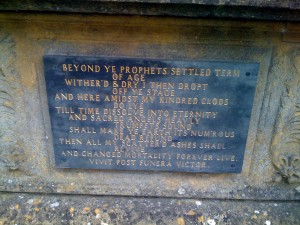Last Sunday evening, I went to the annual John Martin Commemoration service at St Andrew’s church, Hampton. It’s one of the things that local councillors are expected to attend, so I dutifully turned up.
I know very little about John Martin other than the fact that he was a wealthy local landowner who, in his will, left his land to a trust fund to be used for the benefit of the local community. For the first 250 years or so, this was a relatively modest annual amount, but the expansion of Evesham in the 20th century – and particularly the building of the bypass – meant that a lot of the land was sold for large sums of money, which in turn was reinvested into the charity so it’s now a significant local benefactor.
John Martin’s tomb stands proudly in front of the church, you can see the front of it on the charity website. But I was more intrigued with the inscription on the back:
For the benefit of those who find the text on the image hard to read, here’s what it says. Note that “ye”, in this context, is pronounced (and means) “the”, not “yee”:
BEYOND YE PROPHETS SETTLED TERM OF AGE
WITHER’D & DRY I THEN DROPT OFF YE STAGE
AND HERE AMIDST MY KINDRED CLODS DO LYE
TILL TIME DISSOLVE INTO ETERNITY
AND SACRED ANGELS HEAV’LY TRUMPETS SOUND
SHALL MAKE YE EARTH ITS NUM’ROUS DEAD REFUND
THEN ALL MY SCATTER’D ASHES SHALL REVIVE
AND CHANGED MORTALITY FOREVER LIVE
VIVIT POST FUNERA VICTOR
It may not be the greatest piece of poetry ever written, but it has a wry shaft of humour to lead into a fairly standard Christian sentiment of the final resurrection. The last line, though, in Latin, is clearly intended to stand alone rather than be part of the poem. I assumed, when I read it, that it’s a common Latin inscription, but that turns out not to be the case. Google returns no matches at all for that line (well, it will now, of course, but it didn’t before I wrote this article), but a lot for a slight variant. It seems that the usual phrase is “Vivit post funera virtus”, which (according to Google) means “virtue outlives death” or, more colloquially, “character lasts longer than death”. It’s just the sort of thing you’d expect to see on the tomb of someone who is known for his philanthropy.
Replacing the last word with “victor”, though, makes for a slightly more puzzling meaning. Google translate suggests that it means something like “The victor lives after death” or “This victory he lives after death”. Given the last few lines of the poem in English, that fits with an understanding of traditional Christian eschatology. But, if so, it seems a fairly obvious choice of inscription – so why can’t I find examples of it elsewhere?
So, I’m still intrigued. Can anyone else shed any light on this particular phrase, or give examples of other places it’s been used?

